Abstract
In 29 women with postmenopausal osteoporosis, the proportion of total bone surface undergoing resorption or formation was evaluated by microradiography of iliac crest biopsy samples before and after short-term (2½-4 months) and long-term (26-42 months for estrogen and 9-15 months for anabolic hormone) treatment. After estrogen administration, values for bone-resorbing surfaces decreased, although less prominently after long-term than after short-term therapy. The magnitude of this decrease was positively correlated with the pretreatment value for bone-resorbing surfaces (P < 0.001). When the pretreatment value for bone-resorbing surfaces was used as a covariable, estrogen and anabolic hormone appeared to be equally effective. For bone-forming surfaces, short-term therapy with either hormone had no effect but long-term therapy significantly decreased the values. Serum immunoreactive parathyroid hormone (IPTH) increased significantly after estrogen therapy; the change in IPTH was inversely related to the change in serum calcium (P < 0.001, sign test). We conclude that the primary effect of sex hormones in postmenopausal osteoporosis is to decrease the increased level of bone resorption, perhaps by decreasing the responsiveness of bone to endogenous parathyroid hormone. However, this favorable effect, at least in part, is negated after long-term treatment by a secondary decrease in bone formation. Our data are consistent with the concept that the maximal benefit that can be derived from sex hormone therapy in postmenopausal osteoporosis is arrest or slowing of the progession of bone loss.
Full text
PDF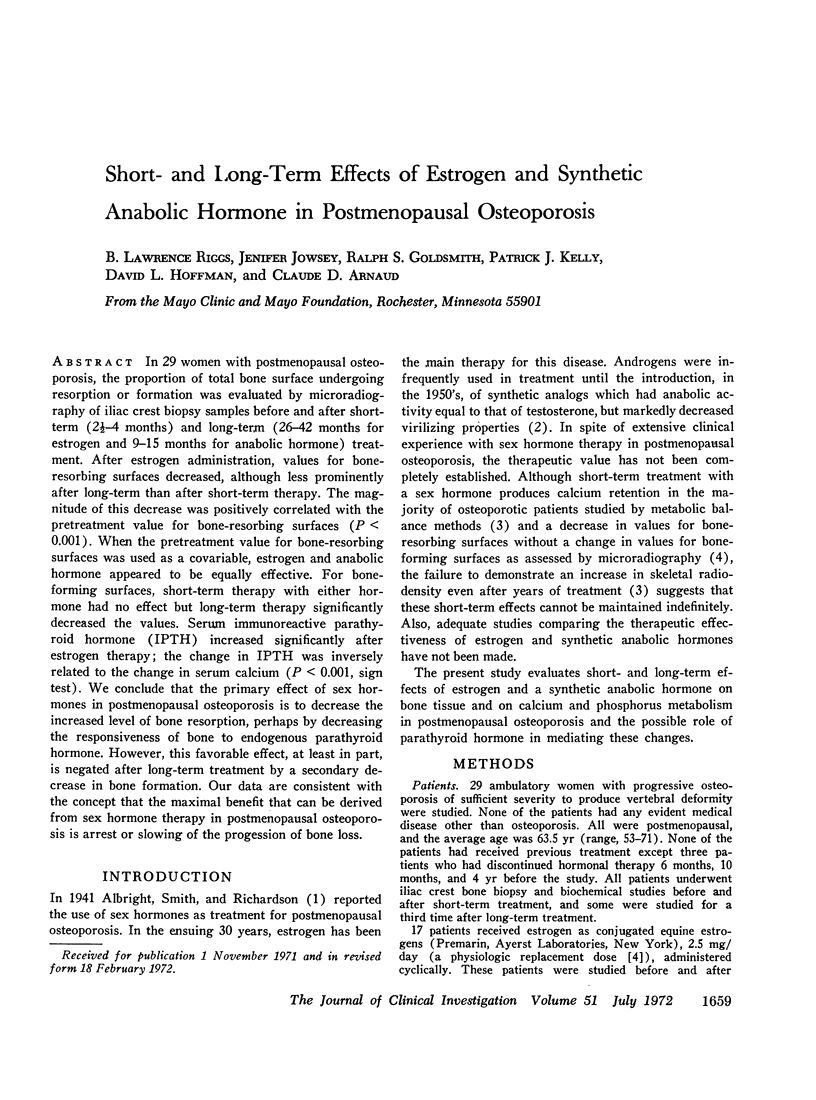
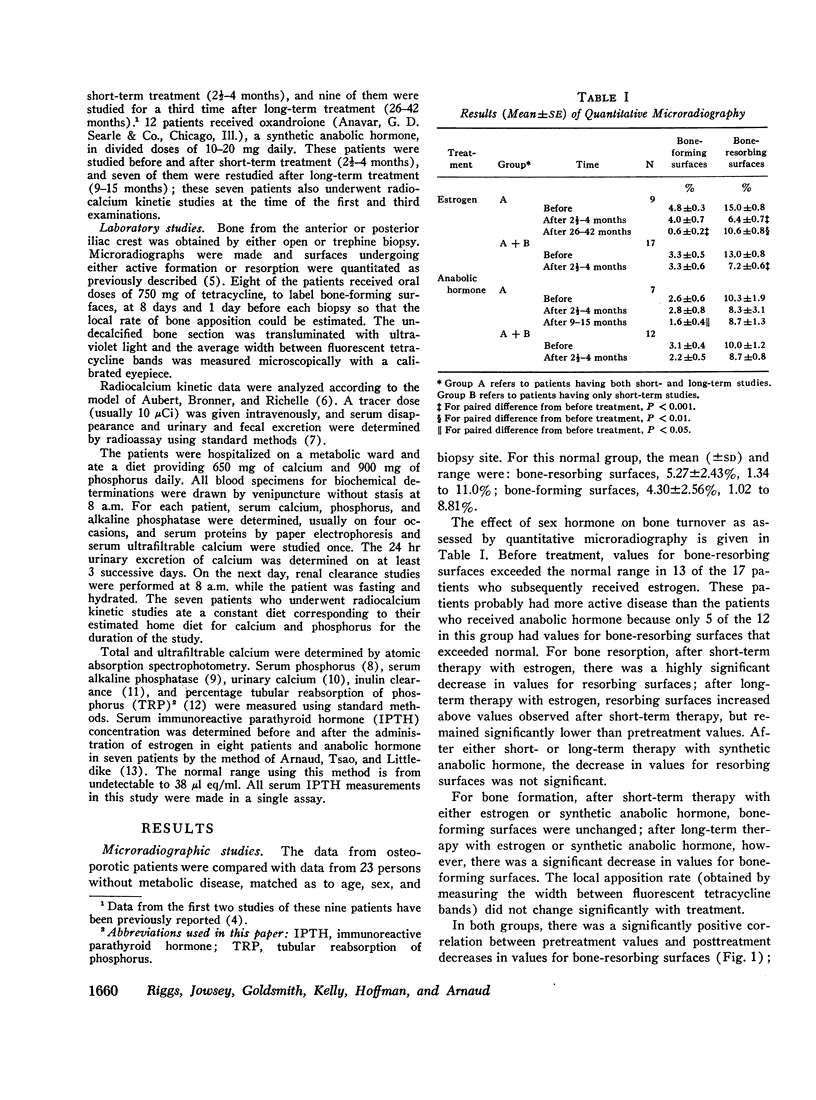
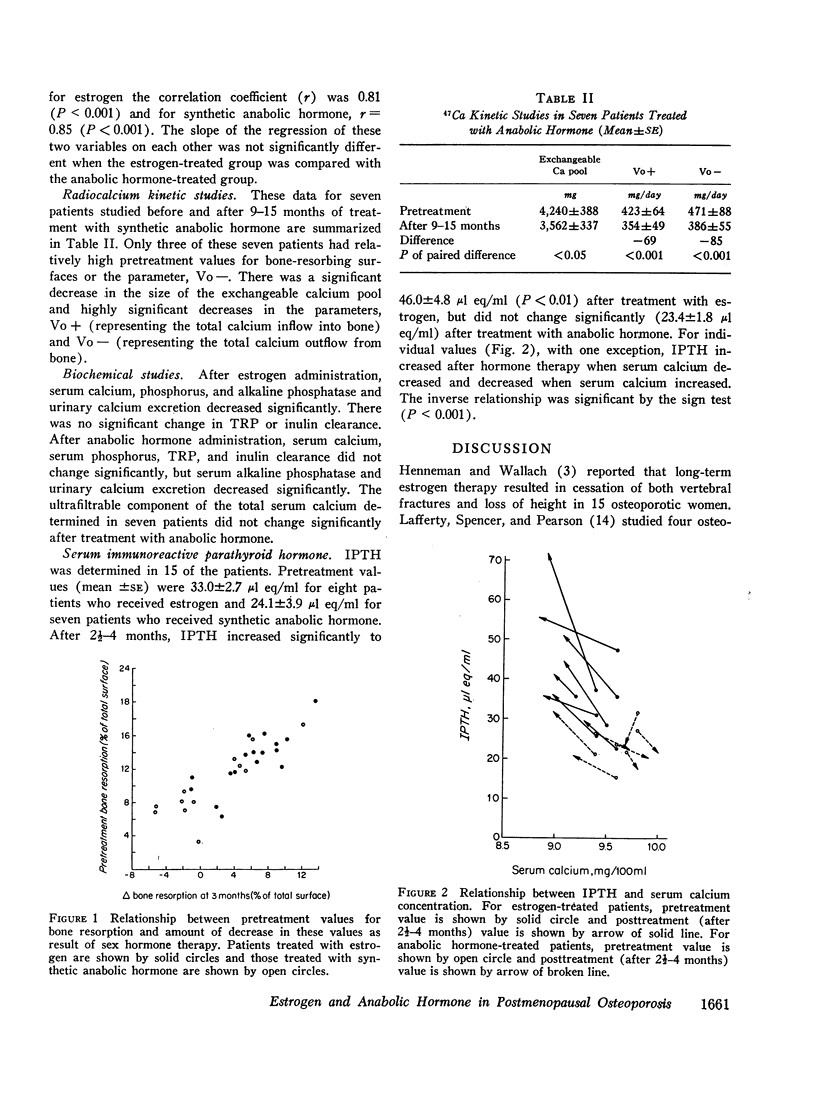
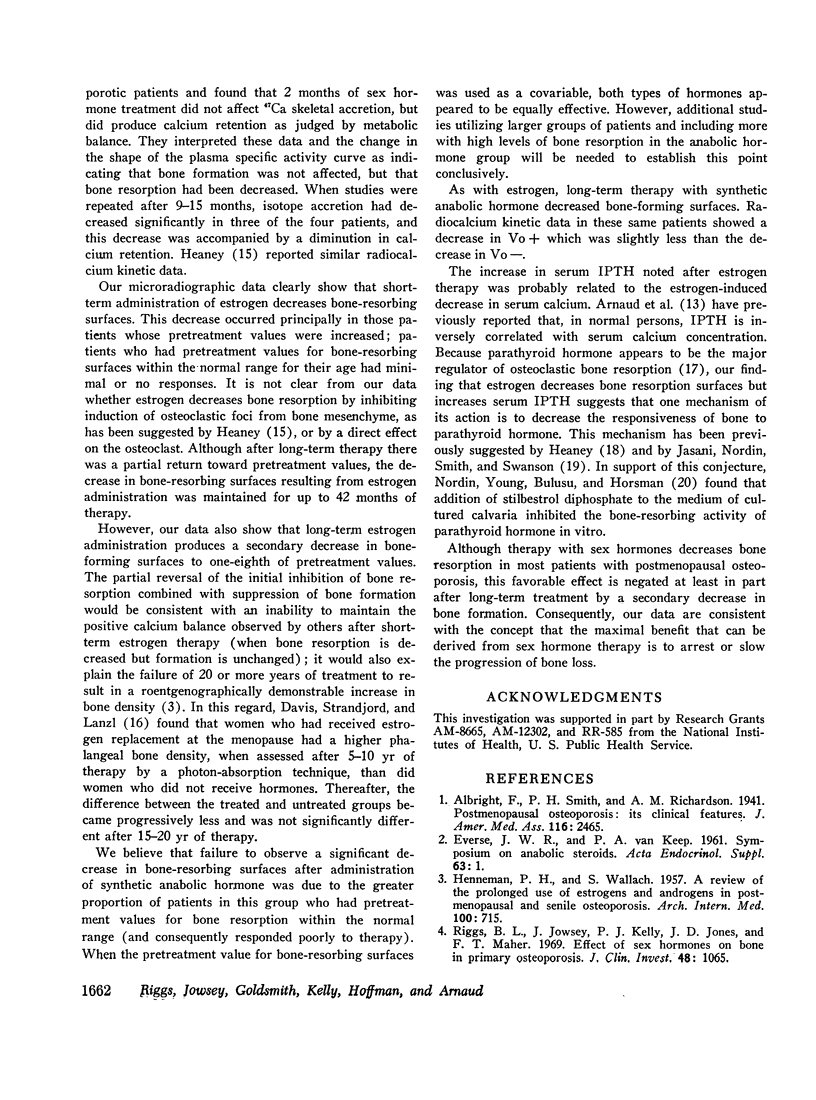
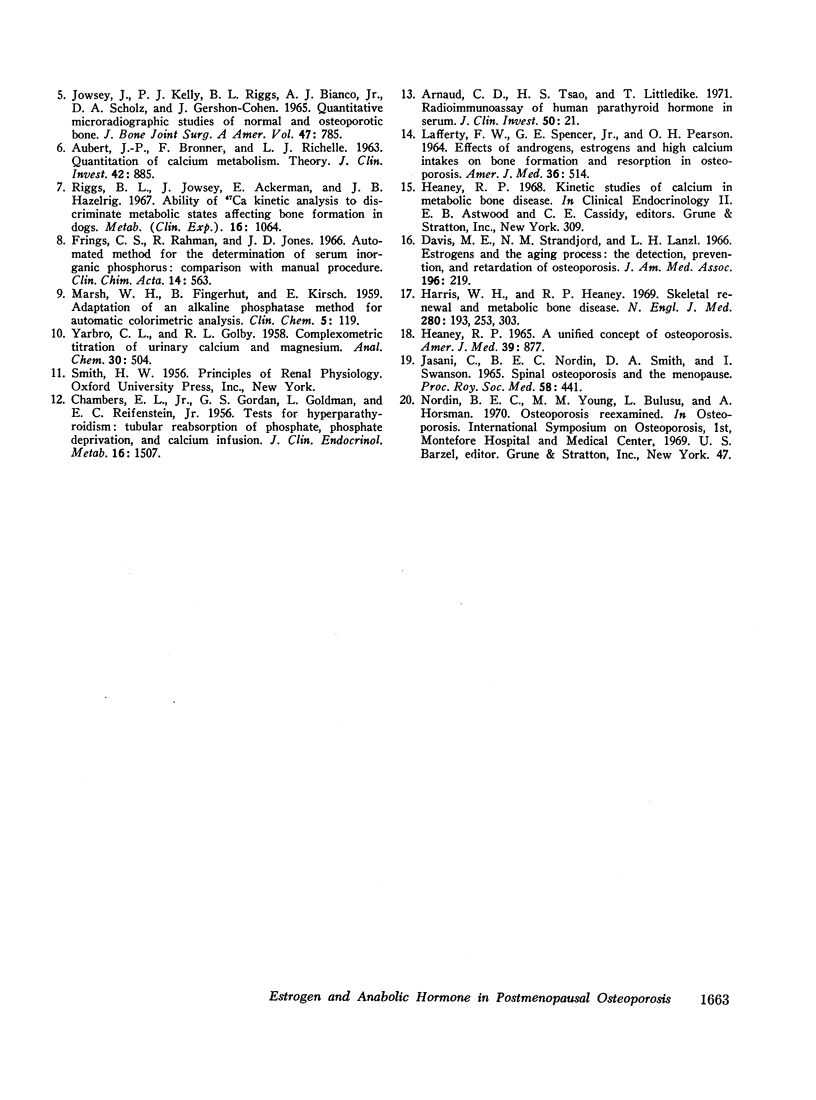
Selected References
These references are in PubMed. This may not be the complete list of references from this article.
- AUBERT J. P., BRONNER F., RICHELLE L. J. Quantitation of calcium metabolism. Theory. J Clin Invest. 1963 Jun;42:885–897. doi: 10.1172/JCI104781. [DOI] [PMC free article] [PubMed] [Google Scholar]
- Arnaud C. D., Tsao H. S., Littledike T. Radioimmunoassay of human parathyroid hormone in serum. J Clin Invest. 1971 Jan;50(1):21–34. doi: 10.1172/JCI106476. [DOI] [PMC free article] [PubMed] [Google Scholar]
- CHAMBERS E. L., Jr, GOLDMAN L., GORDAN G. S., REIFENSTEIN E. C., Jr Tests for hyperparathyroidism: tubular reabsorption of phosphate, phosphate deprivation, and calcium infusion. J Clin Endocrinol Metab. 1956 Nov;16(11):1507–1521. doi: 10.1210/jcem-16-11-1507. [DOI] [PubMed] [Google Scholar]
- Davis M. E., Lanzl L. H., Strandjord N. M. Estrogens and the aging process. The detection, prevention, and retardation of osteoporosis. JAMA. 1966 Apr 18;196(3):219–224. [PubMed] [Google Scholar]
- Frings C. S., Rahman R., Jones J. D. Automated method for the determination of serum inorganic phosphorus. Comparison with manual procedure. Clin Chim Acta. 1966 Oct;14(4):563–565. doi: 10.1016/0009-8981(66)90049-0. [DOI] [PubMed] [Google Scholar]
- HENNEMAN P. H., WALLACH S. A review of the prolonged use of estrogens and androgens in postmenopausal and senile osteoporosis. AMA Arch Intern Med. 1957 Nov;100(5):715–723. doi: 10.1001/archinte.1957.00260110031005. [DOI] [PubMed] [Google Scholar]
- Harris W. H., Heaney R. P. Skeletal renewal and metabolic bone disease. N Engl J Med. 1969 Feb 6;280(6):303–concl. doi: 10.1056/NEJM196902062800605. [DOI] [PubMed] [Google Scholar]
- Heaney R. P. A unified concept of osteoporosis. Am J Med. 1965 Dec;39(6):877–880. doi: 10.1016/0002-9343(65)90109-9. [DOI] [PubMed] [Google Scholar]
- JASANI C., NORDIN B. E., SMITH D. A., SWANSON I. SPINAL OSTEOPOROSIS AND THE MENOPAUSE. Proc R Soc Med. 1965 Jun;58:441–444. doi: 10.1177/003591576505800622. [DOI] [PMC free article] [PubMed] [Google Scholar]
- JOWSEY J., PHIL D., KELLY P. J., RIGGS B. L., BIANCO A. J., Jr, SCHOLZ D. A., GERSHON-COHEN J. QUANTITATIVE MICRORADIOGRAPHIC STUDIES OF NORMAL AND OSTEOPOROTIC BONE. J Bone Joint Surg Am. 1965 Jun;47:785–806. [PubMed] [Google Scholar]
- LAFFERTY F. W., SPENCER G. E., Jr, PEARSON O. H. EFFECTS OF ANDROGENS, ESTROGENS AND HIGH CALCIUM INTAKES ON BONE FORMATION AND RESORPTION IN OSTEOPOROSIS. Am J Med. 1964 Apr;36:514–528. doi: 10.1016/0002-9343(64)90100-7. [DOI] [PubMed] [Google Scholar]
- MARSH W. H., FINGERHUT B., KIRSCH E. Adaptation of an alkaline phosphatase method for automatic colorimetric analysis. Clin Chem. 1959 Apr;5(2):119–126. [PubMed] [Google Scholar]
- Riggs B. L., Jowsey J., Ackerman E., Hazelrig J. B. Ability of 47 Ca kinetic analysis to discriminate metabolic states affecting bone formation in dogs. Metabolism. 1967 Nov;16(11):1064–1073. doi: 10.1016/0026-0495(67)90102-3. [DOI] [PubMed] [Google Scholar]
- Riggs B. L., Jowsey J., Kelly P. J., Jones J. D., Maher F. T. Effect of sex hormones on bone in primary osteoporosis. J Clin Invest. 1969 Jun;48(6):1065–1072. doi: 10.1172/JCI106062. [DOI] [PMC free article] [PubMed] [Google Scholar]


